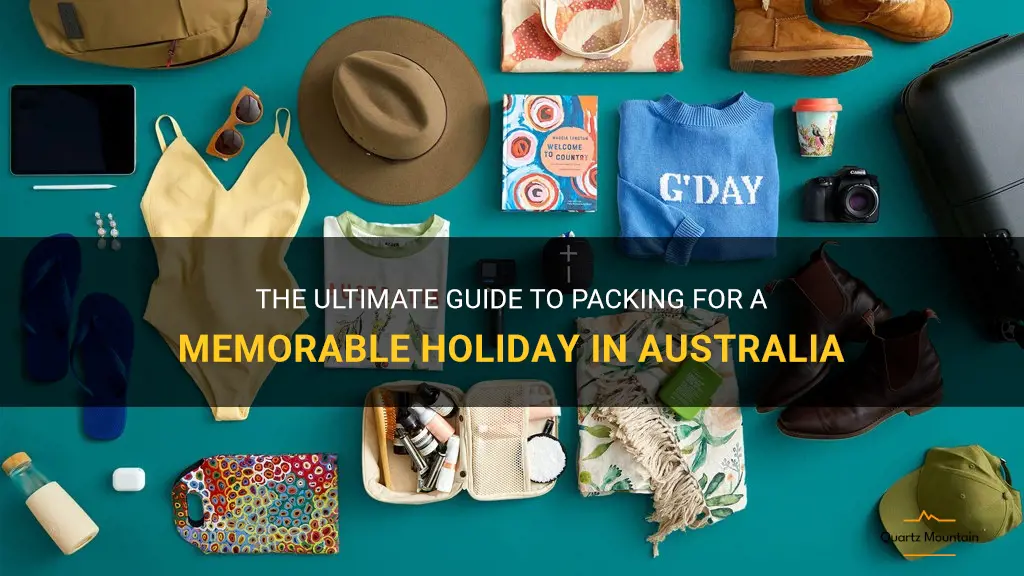
Australia is a vast and diverse country with so much to offer visitors, from stunning beaches and bustling cities to rugged outback landscapes and unique wildlife. If you're planning a trip down under, it's essential to pack wisely to ensure that you have everything you need for a memorable holiday. In this ultimate guide, we'll take you through all the essentials you'll need to pack for an unforgettable adventure in Australia, from practical clothing and gear to must-have travel accessories. So let's dive in and get you ready to explore all that this incredible country has to offer!
| Characteristics | Values |
|---|---|
| Clothing | Swimwear, shorts, t-shirts |
| Footwear | Sandals, flip flops, sneakers |
| Accessories | Sunscreen, sunglasses, hat |
| Electronics | Camera, chargers, adapters |
| Toiletries | Toothbrush, toothpaste, shampoo |
| Medications | Prescriptions, first aid kit |
| Documents | Passport, visa, travel insurance |
| Money | Australian dollars, credit card |
| Entertainment | Books, headphones, playing cards |
What You'll Learn
- What are the essential clothing items to pack for a holiday in Australia?
- Are there any specific items I should pack for protection against the Australian sun?
- What should I pack for hiking or outdoor activities in Australia?
- Are there any items that are advised to leave at home when traveling to Australia?
- Are there any specific cultural considerations that should affect what I pack for a holiday in Australia?

What are the essential clothing items to pack for a holiday in Australia?

When planning a holiday in Australia, it is important to pack accordingly to ensure you have the right clothing for the country's diverse climate and activities. Australia is known for its beautiful beaches, vibrant cities, and rugged outback, so you will need a range of clothing items to cater to different environments and weather conditions. Here are some essential clothing items to pack for a holiday in Australia.
- Swimwear: Australia has some of the most stunning beaches in the world, so make sure to pack your swimwear. Whether you plan on soaking up the sun on Bondi Beach in Sydney or exploring the Great Barrier Reef in Queensland, having a good quality swimsuit is a must.
- Sun-protective clothing: Australia is known for its strong sun, so packing sun-protective clothing is essential. Look for lightweight, long-sleeved shirts and pants with a high UPF (Ultraviolet Protection Factor) rating to shield your skin from harmful UV rays. Wide-brimmed hats and sunglasses are also important to protect your face and eyes.
- Light and comfortable clothing: Australia can get quite hot, especially during the summer months. Pack light and breathable clothing such as t-shirts, shorts, and dresses made from natural fibers like cotton or linen. Opt for loose-fitting garments to increase airflow and keep you cool.
- Layering options: Although Australia is known for its warmth, the temperature can drop significantly during the evenings, particularly in desert regions or mountainous areas. It is wise to pack some lightweight sweaters or jackets that can be layered over your daytime clothes to stay warm when the sun goes down.
- Comfortable shoes: Australia is a vast country with diverse landscapes, so having comfortable shoes is crucial. For city exploration, pack a pair of comfortable walking shoes or sneakers. If you plan to hike in national parks or explore the Outback, consider sturdy hiking boots or closed-toe shoes for better protection and grip on uneven terrain.
- Insect repellent clothing: Australia is home to a variety of insects, including mosquitoes. To avoid getting bitten, it is advisable to pack insect repellent clothing or apply insect repellent on exposed skin. Look for clothing treated with insect repellent or purchase insect repellent sprays or creams designed for application on clothing.
- Rainproof gear: Depending on the time of year and the region you are visiting, rain can be a factor to consider. Pack a lightweight, foldable rain jacket or poncho to stay dry during unexpected showers. Umbrellas can also come in handy, especially in urban areas with frequent rainfall.
It is important to adapt your clothing choices based on the specific activities you plan on doing during your holiday in Australia. If you are an outdoor enthusiast planning on hiking or camping, remember to pack appropriate gear such as a sturdy backpack, camping equipment, and quick-drying clothing. If your itinerary includes visits to museums, restaurants, and other urban attractions, pack some dressier outfits for those occasions.
Remember to check the weather forecast for the regions you will be visiting to ensure you have the right clothing items for the expected conditions. It is always better to pack a variety of clothing options to be prepared for any changes in weather or spontaneous activities that may arise during your holiday in Australia.
Essential Items to Pack for Your Trip to Ho Chi Minh City
You may want to see also

Are there any specific items I should pack for protection against the Australian sun?
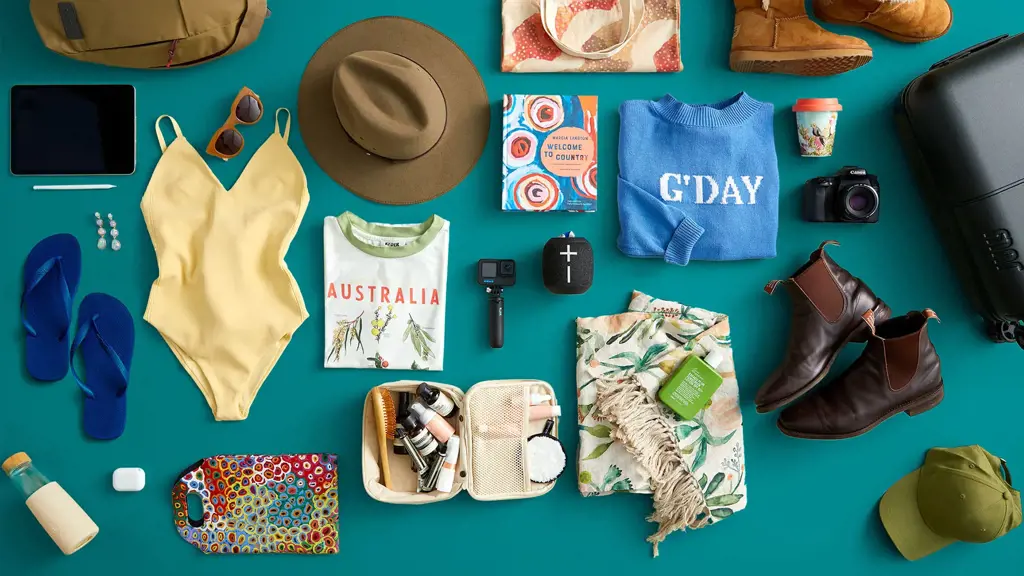
When visiting or living in Australia, it's important to protect yourself from the harsh Australian sun. The strong ultraviolet (UV) rays can cause serious damage to your skin and increase the risk of skin cancer. To ensure you stay safe and enjoy your time in the sun, here are some specific items you should pack for protection against the Australian sun.
- Sunscreen: This is perhaps the most important item to pack. Look for a broad-spectrum sunscreen with a high SPF (Sun Protection Factor) of at least 30. Apply it generously to all exposed areas of your skin, including your face, neck, arms, and legs. Reapply every two hours, or more frequently if you are sweating or swimming.
- Wide-brimmed hat: A wide-brimmed hat can provide excellent shade and protection for your face, neck, and ears. Look for a hat with a brim that is at least 3 inches wide, and made from a tightly woven material that blocks the sun.
- Sunglasses: Protect your eyes from harmful UV rays by wearing sunglasses that block 100% of UVA and UVB rays. Look for a pair that fits well and has a wrap-around style to ensure maximum protection.
- UPF-rated clothing: Consider packing clothing that has a UPF (Ultraviolet Protection Factor) rating. UPF clothing is specially designed to block UV rays and provides excellent protection for your skin. Look for clothing with a UPF rating of 50+ for the best protection.
- Rash guard or swim shirt: If you plan on spending time at the beach or in the water, a rash guard or swim shirt can offer additional protection. These shirts are made from UPF-rated fabric and can protect your upper body from sunburn.
- Sun umbrella: If you're planning on spending a lot of time outdoors, a portable sun umbrella can provide much-needed shade. Look for an umbrella that is large enough to cover you and your belongings.
- Lip balm with SPF: Don't forget to protect your lips from the sun as well. Look for a lip balm that has SPF protection to prevent sunburn and dryness.
- Aloe vera gel: Despite your best efforts, sunburn can still happen. Pack aloe vera gel to soothe and moisturize your skin if you do get sunburned. The cooling properties of aloe vera can provide relief and help your skin heal faster.
In addition to packing these items, it's also important to practice sun-safe behaviors. Seek shade during the peak sun hours, usually between 10 am and 4 pm, when the sun's rays are the strongest. Wear lightweight, breathable clothing that covers your skin, and drink plenty of water to stay hydrated in the hot Australian climate.
Remember, protecting yourself from the Australian sun is not just important during the summer months. UV rays can be strong year-round, so make sun protection a part of your daily routine no matter the season. By taking these precautions and packing the right items, you can enjoy the beautiful Australian sun while keeping your skin healthy and safe.
Essential Items to Pack for Your Bermuda Cruise
You may want to see also

What should I pack for hiking or outdoor activities in Australia?
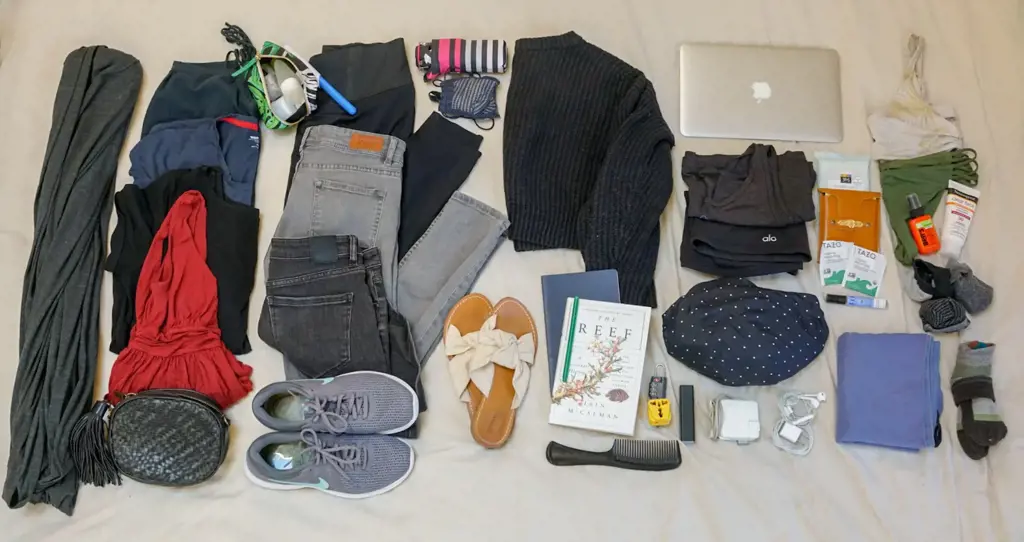
Australia is known for its stunning landscapes and outdoor activities, making it a popular destination for hikers and outdoor enthusiasts. Whether you're planning a day hike or a multi-day trek, it's important to pack the right gear to ensure a safe and enjoyable experience. Here are some essential items to include in your hiking or outdoor activity pack:
Clothing:
- Lightweight, moisture-wicking shirts and pants to keep you cool and dry.
- A waterproof and breathable jacket to protect you from rain and wind.
- Sturdy hiking boots with good ankle support and traction.
- Comfortable socks to prevent blisters.
- A wide-brimmed hat to protect your face and neck from the sun.
- Sunglasses to shield your eyes from harmful UV rays.
Navigation:
- A detailed map of the area you'll be exploring.
- A compass to help you navigate your way.
- A GPS device or a smartphone with a hiking app for added navigation support.
- Extra batteries or a portable charger to ensure your devices don't run out of power.
Safety and First Aid:
- A whistle to attract attention in case of emergency.
- A fully stocked first aid kit with basic supplies such as bandages, antiseptic wipes, and pain relievers.
- A multi-tool, which can be handy for various tasks such as cutting rope or repairing gear.
- A headlamp or flashlight with extra batteries for nighttime visibility.
- A lightweight emergency blanket to provide warmth in case of unexpected weather changes.
Food and Water:
- High-energy snacks such as trail mix, energy bars, and dried fruits.
- A portable water filter or water purification tablets to ensure a safe drinking supply.
- A lightweight and durable water bottle or hydration bladder to stay hydrated throughout your hike.
- A small camping stove and cookware if you plan on cooking your meals.
Shelter and Sleeping:
- A lightweight and compact tent or hammock for overnight trips.
- A sleeping bag suitable for the climate and season.
- A sleeping pad for added comfort and insulation.
Personal Items:
- Sunscreen to protect your skin from the harsh Australian sun.
- Insect repellent to ward off mosquitoes and other biting insects.
- Toilet paper and a trowel for proper waste disposal.
- Personal hygiene items such as toothbrush, toothpaste, and biodegradable soap.
- Zip-lock bags to keep your items dry and organized.
Communication and Emergencies:
- A fully charged mobile phone with emergency contact numbers stored.
- A personal locator beacon (PLB) or satellite communication device for remote areas without cell service.
Before heading out on your hike or outdoor adventure, it's important to research the specific requirements and conditions of the area you'll be visiting. Pay attention to any special regulations, weather forecasts, and potential hazards. Additionally, always inform someone of your plans and expected return time for added safety. By packing the right gear and taking necessary precautions, you can have a memorable and safe outdoor experience in Australia.
Ultimate Guide: Essential Items to Pack for a Man's Lunch
You may want to see also

Are there any items that are advised to leave at home when traveling to Australia?
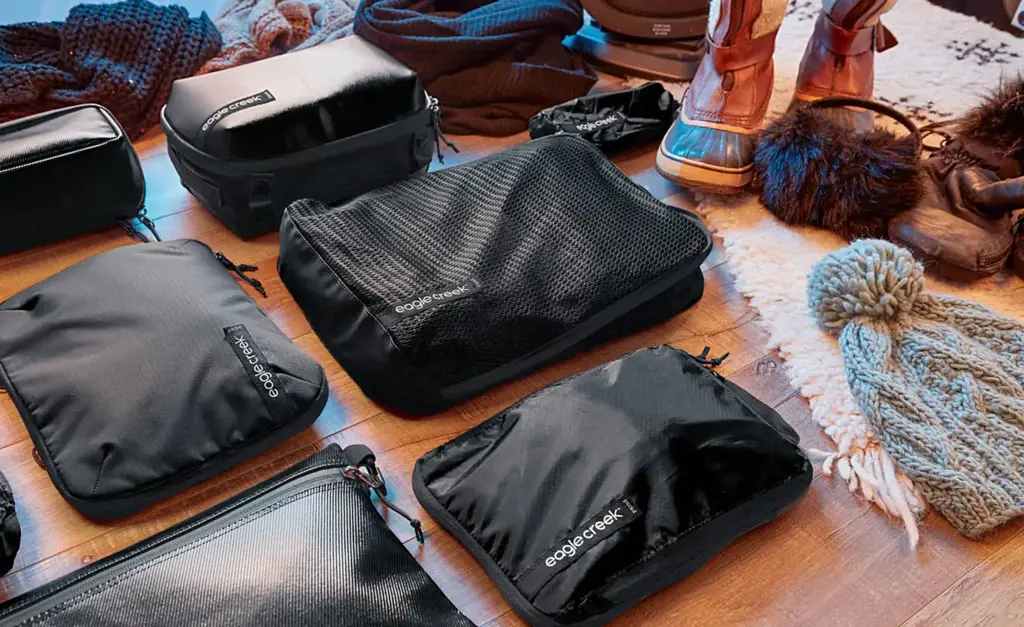
When traveling to Australia, it is important to be aware of the country's strict regulations on what items are allowed to be brought into the country. There are several items that are advised to be left at home when traveling to Australia to avoid any complications or fines.
One such item is food. Australia has very strict regulations on bringing food into the country, especially fresh produce, meat, and dairy products. These regulations are in place to protect Australia's unique ecosystems and agricultural industries from the introduction of foreign pests and diseases. It is always best to check Australia's Department of Agriculture and Water Resources website before traveling to see what food items are restricted or prohibited.
Another item that is advised to be left at home when traveling to Australia is any kind of weapon or firearm. Australia has very strict gun control laws, and it is illegal to bring firearms or certain types of weapons into the country without the proper permits and licenses. It is best to check with the Australian Border Force to see what types of weapons are restricted or prohibited before traveling.
Additionally, it is advised to leave any illegal drugs or substances at home. Australia has strict laws regarding drug possession and trafficking, and penalties can be severe. It is not worth the risk to try and bring illegal drugs into the country.
Other items that are advised to be left at home when traveling to Australia include animals and plants (unless with proper permits), asbestos-containing materials, certain types of medications, and pornography. It is always best to check with the Australian Border Force website or contact them directly to see what items are restricted or prohibited before traveling.
In conclusion, when traveling to Australia, it is important to be aware of the country's strict regulations on what items are allowed to be brought into the country. It is advised to leave items such as food, weapons, illegal drugs, animals and plants (unless with proper permits), asbestos-containing materials, certain medications, and pornography at home to avoid complications or penalties. Always check with the Australian Border Force for the most up-to-date information on restricted or prohibited items before traveling.
Essential Items to Pack for Your Adventure on Survivor: A Comprehensive Guide
You may want to see also

Are there any specific cultural considerations that should affect what I pack for a holiday in Australia?
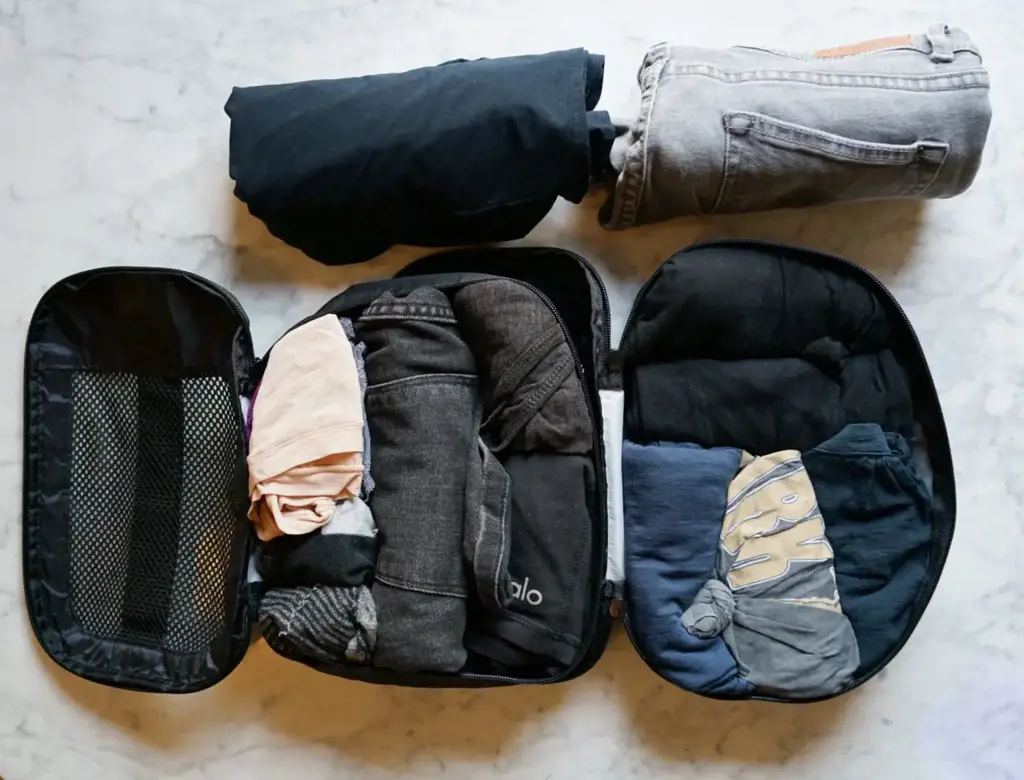
When visiting Australia, it’s important to consider the country’s unique cultural aspects so you can pack appropriately for your trip. Australia is known for its diverse landscapes, wildlife, and outdoor activities, as well as its laid-back lifestyle. Here are some cultural considerations to keep in mind when deciding what to pack for your holiday in Australia:
- Climate: Australia has a wide range of climates, from tropical in the north to temperate in the south. It’s essential to check the weather forecast for your specific destination and pack accordingly. In the summer months, lightweight and breathable clothing, such as t-shirts, shorts, and dresses, are essential. Don’t forget to pack a hat, sunglasses, and sunscreen to protect yourself from the strong Australian sun. In the cooler months, layering is key, as temperatures can vary throughout the day. Pack a mix of warm clothing, including sweaters, jackets, and long-sleeved shirts, depending on the region you are visiting.
- Beachwear: Australia is famous for its stunning beaches, so if you plan to spend time by the coast, don’t forget to pack your swimwear, beach towel, and sunscreen. Australians are generally relaxed when it comes to beach attire, so feel free to embrace the laid-back beach culture and pack casual and comfortable beachwear.
- Outdoor activities: Australia offers numerous outdoor activities, such as hiking, camping, and water sports. If you plan to engage in these activities, be sure to pack appropriate gear. Sturdy, comfortable footwear is a must for hiking and walking trails. Pack lightweight, quick-drying clothing suitable for outdoor activities, as well as a good-quality backpack to carry necessary items like water bottles, snacks, and maps.
- Respect the culture: Australia is a multicultural country, and it’s important to respect and appreciate the various cultures and traditions you may encounter. When visiting Aboriginal sites or cultural centers, it’s respectful to dress modestly and follow any specific guidelines provided. When attending religious or cultural events, it is advisable to dress more formally and conservatively.
- Insect repellent: Australia is home to a variety of insects, including mosquitoes, ticks, and spiders. It’s a good idea to pack insect repellent to protect yourself from bites, especially if you plan to spend time outdoors or in more rural areas. Consider packing lightweight, long-sleeved shirts and pants to further protect yourself from insect bites.
- Electrical items: Australia uses a different electrical outlet type compared to many other countries, so make sure to bring a universal adapter if you plan on using any electrical devices, such as chargers or hair dryers.
- Medications and health considerations: If you have any specific medical conditions or require prescription medications, it’s important to bring an adequate supply with you. Australia has high-quality medical facilities, but it’s always best to be prepared. Additionally, if you are exploring the outback or more remote areas, consider packing a basic first aid kit with essentials like band-aids, antiseptic cream, and pain relievers.
By considering these cultural aspects and packing accordingly, you can ensure a more comfortable and enjoyable holiday experience in Australia. Remember to research your specific destination and plan ahead to make the most of your time in this beautiful country.
Essential Items to Pack for a 7-Day Ski Trip
You may want to see also
Frequently asked questions
Australia has a varied climate, so it's important to pack a range of clothing. In the summer months, light and breathable clothing such as shorts, t-shirts, and dresses are recommended. In the cooler months, especially in the southern regions, it's a good idea to bring some warmer layers such as a light jacket or sweater.
Absolutely! Australia is known for its beautiful beaches and swimming spots. Whether you're planning to visit the iconic Bondi Beach in Sydney or snorkel the Great Barrier Reef, a swimsuit is a must-pack item. Don't forget to also bring a beach towel and sunscreen to protect yourself from the strong Australian sun.
The type of footwear you should pack largely depends on the activities you have planned. If you'll be doing a lot of walking and hiking, it's advisable to bring comfortable walking shoes or hiking boots. For a more casual holiday or city exploration, a pair of comfortable sneakers or sandals should suffice. Also, don't forget to pack a pair of flip-flops or "thongs" as they're called in Australia, as they're essential for the beach or poolside.
Australia is home to a variety of insects, including mosquitoes and sandflies, especially in the warmer months. It's a good idea to pack some insect repellent to protect yourself from their bites. Look for a repellent that contains the active ingredient DEET or picaridin for effective protection.
If you're planning to visit the Australian Outback, there are a few specific items you should pack. Firstly, a wide-brimmed hat and sunglasses are essential for protecting yourself from the intense sun. It's also important to pack plenty of water and a reusable water bottle to stay hydrated. Additionally, lightweight, loose-fitting clothing made from breathable fabrics such as cotton is recommended to keep cool. Don't forget to also pack sunscreen and insect repellent, as insects can be prevalent in certain areas of the Outback.







